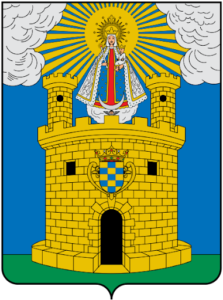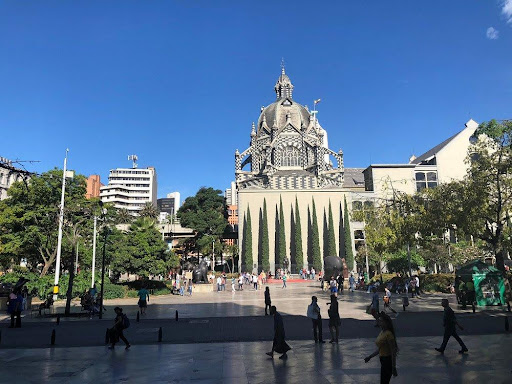Medellin
Department

Flag of the city
The coat-of-arms in blue field shows a gold tower and above the door a shield checky, 7 parts blue and 8 gold. In the upper part two towers and between them the image of Nuestra Sen~ora de la Candelaria (Our Lady of the Candelmas), the town’s patron saint; the coat of arms of Medellin was granted by Royal Grant given in Madrid by King Charles II.

Seal of the city
In a field of azure, a round keep of gold, rounded and clarified of sable, charged with a shield of 15 pieces, 7 blue and 8 gold (arms of the house of Portocarrero), stamped with an ancient crown of gold, and surmounted, between its two turrets, by the image of Our Lady of Candelaria carrying the Child, in his left arm, and a candle in his right hand, with clouds rising from each canton.

Slogan of the city
Slogan of the city “Medellín es una flor” which translates to “Medellín is a flower.” This pays homage to the annual Feria de las Flores or Flower Festival, one of the city’s most iconic events.
History
In August 1541, Marshal Jorge Robledo, while at what’s currently known as Heliconia, spotted a distant valley. He dispatched Jerónimo Luis Tejelo to explore this land, and by the night of August 23, Tejelo had discovered what we now identify as the Aburrá Valley. Originally named “Valley of Saint Bartholomew” by the Spaniards, it was soon renamed Aburrá, a name signifying “Painters”, inspired by the textile embellishments of local leaders.
By 1574, Gaspar de Rodas requested land from Antioquia’s Cabildo to cultivate herds and establish a ranch in the valley. He was granted a piece of land measuring 8 square kilometers.
In 1616, Francisco de Herrera y Campuzano, a colonial visitor, set up a settlement with 80 Amerindians and christened it Poblado de San Lorenzo, now recognized as “El Poblado”. By 1646, a colonial directive mandated the segregation of Amerindians from mestizos and mulattos. Consequently, a new town began to emerge in Aná, presently Berrío Park. This was where they constructed the church of Nuestra Señora de la Candelaria de Aná. A few years afterward, work commenced on the Basilica of Our Lady of Candelaria, which underwent reconstruction towards the end of the 18th century. Following Gaspar de Rodas’ settlement in the valley, the population surged. Church archives from San Lorenzo Church indicate that numerous couples wed during the latter part of the 17th century. Gold mines set up in northeast Antioquia required food provisions, placing Aburrá Valley at a strategic juncture between these mines and the initial provincial capital of Antioquia, Santa Fe de Antioquia.
As Santa Fe de Antioquia, the provincial capital, dwindled in prominence and affluence, the Aburrá Valley started drawing traders and notable figures. Affluent families began acquiring lands in the valley. In time, there were calls for a separate governance structure for the valley, independent of Santa Fe. Even though Santa Fe resisted, Mariana of Austria authorized the creation of a Cabildo in the valley. The official proclamation came from the governor Miguel de Aguinaga on November 2, 1675. The burgeoning city was christened Villa de Nuestra Señora de la Candelaria.
Geography of the city
Medellín has 16 districts, 5 townships, and 271 neighborhoods. Medellín, located at approximately 6.2442° N latitude and 75.5812° W longitude, is the capital city of the Antioquia department in Colombia. Nestled within the central region of the Andes Mountains, specifically in the Aburrá Valley, the city enjoys an elevation of about 1,495 meters (4,905 feet) above sea level. This prominent position within the valley, running from the north to the south, dictates the city’s elongated spread. Surrounded by verdant mountains, Medellín’s moderate climate has earned it the nickname “City of Eternal Spring”. The Medellín River meanders through the valley, serving as a natural divider for the city’s eastern and western regions. Additionally, the city’s mountainous topography has heavily influenced its urban layout, with ‘comunas’ or neighborhoods, stretching up the slopes, providing panoramic views of the sprawling valley below.

Population
In 2023, the metropolitan population of Medellin stands at 4,102,000, reflecting a growth of 0.84% from 2022. The previous year, 2022, saw the metro population at 4,068,000, marking a 0.84% rise from 2021. In 2021, the number was 4,034,000, which was a 0.85% jump from 2020.
4,102,000 (2023)
4,068,000(2022)
One photo representative of the city
Medellín ranks as Colombia’s second-biggest city and boasts remarkable modern architecture. While it once had a reputation as one of the globe’s most perilous cities due to drug-related activities, it has now transformed into a delightful destination. The city offers vast lush parks, trendy districts, lively evening entertainment, and captivating museums, ensuring a plethora of activities for visitors.
Plaza Botero is a prominent public space situated in the heart of Medellín’s historical downtown. Renowned for its art, this plaza proudly showcases 23 monumental bronze sculptures, all masterpieces of the celebrated Colombian artist, Fernando Botero. These sculptures exemplify Botero’s signature style, often referred to as “Boterismo”, which is characterized by proportionally exaggerated or inflated shapes. The plaza, surrounded by architectural treasures and bustling with local vendors and tourists alike, is not just an artistic hub but also a testament to Medellín’s transformation and cultural renaissance. Adjacent to the plaza is the Museum of Antioquia, which houses many more works by Botero, making the entire area a must-visit for art enthusiasts and those looking to immerse themselves in the city’s rich culture.

Etymology
The name “Medellín” has historical roots tracing back to the early colonial era of the Americas. This Colombian city’s name is believed to have been inspired by the Spanish town of Medellín in the province of Badajoz. The connection emerges from Martín Esteban de Orellana, a Spanish conquistador and marshal instrumental in the early history of Colombia’s Antioquia region. Born in the Spanish Medellín, Orellana’s exploits in the New World led to the naming of the Colombian settlement in homage to his place of birth. As the Colombian Medellín developed and thrived, eventually becoming a pivotal hub in both cultural and economic realms, its global recognition overshadowed that of its Spanish counterpart. Today, for many worldwide, the name Medellín is predominantly associated with the dynamic Colombian metropolis, reflecting its evolution and importance on the global stage.
What the city is known or famous for
Medellín is known for the “City of Eternal Spring” for its consistently temperate climate, stands as a beacon of resilience and transformation in the global context. One of the city’s most iconic contributions to the world of art is its public display of Fernando Botero’s works. Plaza Botero, situated in the heart of the city, showcases 23 of the artist’s monumental sculptures. Additionally, the nearby Museum of Antioquia is a repository of many other Botero masterpieces. Beyond its artistic significance, Medellín has gained international acclaim for its forward-thinking urban initiatives. Notably, the city has ingeniously integrated cable cars and outdoor escalators as means of public transportation. These initiatives not only enhance connectivity within its mountainous terrain but also symbolize the city’s dedication to social inclusivity, bridging historically marginalized neighborhoods with the city’s commercial and cultural centers. This blend of cultural richness and innovative urbanism defines Medellín’s modern identity.

